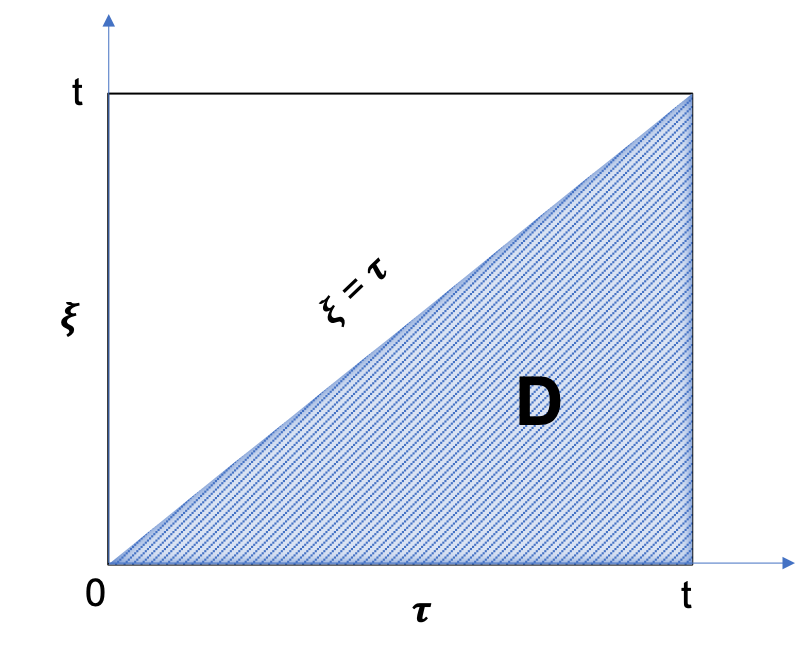Consider a system of net hydrocarbon pay and finite volume Aquifer as a radial composite reservoir with inner composite area being a Net Pay Area and outer composite area an Aquifer
(see schematic and notations on Fig. 1 at Radial VEH Aquifer Drive @model).
The Aquifer's outer boundary may be "no-flow" or full pressure support, thus implementing the case of the infinite-volume Aquifer.
The transient pressure diffusion in the outer (Aquifer) composite area is going to honour the following equation:
| (1) |
\frac{\partial p_a}{\partial t} = \chi \cdot \left[ \frac{\partial^2 p_a}{\partial r^2} + \frac{1}{r}\cdot \frac{\partial p_a}{\partial r} \right] |
| | |
| (4) |
\frac{\partial p_a}{\partial r}
\bigg|_{(t, r=r_a)} = 0 |
or
| (5) |
p_a(t, r = \infty) = 0 |
|
Consider dimensionless solution
p_1(t_D, r_D) of the following equation:
| (6) |
\frac{\partial p_1}{\partial t_D} = \frac{\partial^2 p_1}{\partial r_D^2} + \frac{1}{r_D}\cdot \frac{\partial p_1}{\partial r_D} |
| | |
| (9) |
\frac{\partial p_1(t_D, r_D)}{\partial r_D}
\Bigg|_{r_D=r_{aD}} = 0 |
or
| (10) |
p_1(t_D, r_D = \infty) = 0 |
|
which represents a specific function of dimensionless time
t_D and distance
r_D.
Now consider a convolution integral:
| (11) |
p_a(t, r) = p(0) + \int_0^t p_1 \left(\frac{(t-\tau) \cdot \chi}{r_e^2}, \frac{r}{r_e} \right) \dot p(\tau) d\tau |
|
| (12) |
\dot p(\tau) = \frac{d p}{d \tau} |
|
One can easily check that
(11) honours the whole set of equations
(1)–
(4) and as such defines a unique solution of the above problem.
Water flowrate within
\theta sector angle at interface with oil reservoir will be:
| (13) |
q^{\downarrow}_{AQ}(t)= \theta \cdot r_e \cdot h \cdot u(t,r_e) |
where
u(t,r_e) is flow velocity at aquifer contact boundary, which is:
| (14) |
u(t,r_e) = M \cdot \frac{\partial p_a(t,r)}{\partial r} \bigg|_{r=r_e} |
where
\displaystyle M = \frac{k_w}{\mu_w} is aquifer mobility.
Water flowrate becomes:
| (15) |
q^{\downarrow}_{AQ}(t)= \theta \cdot r_e \cdot h \cdot M \cdot \frac{\partial p_a(t,r)}{\partial r} \bigg|_{r=r_e} |
Cumulative water flux:
| (16) |
Q^{\downarrow}_{AQ}(t) = \int_0^t q^{\downarrow}_{AQ}(t) dt = \theta \cdot r_e \cdot h \cdot M \cdot \int_0^t \frac{\partial p_a(t,r)}{\partial r} \bigg|_{r=r_e} dt |
Substituting
(11) into
(16) leads to:
| (17) |
Q^{\downarrow}_{AQ}(t) = \theta \cdot r_e \cdot h \cdot M \cdot \int_0^t d\xi \ \frac{\partial }{\partial r} \left[
\int_0^\xi p_1 \left( \frac{(\xi-\tau)\chi}{r_e^2}, \frac{r}{r_e} \right) \, \dot p(\tau) d\tau
\right]_{r=r_e} |
| (18) |
Q^{\downarrow}_{AQ}(t) = \theta \cdot h \cdot M \cdot \int_0^t d\xi \ \frac{\partial }{\partial r_D} \left[
\int_0^\xi p_1 \left( \frac{(\xi-\tau)\chi}{r_e^2}, r_D \right) \, \dot p(\tau) d\tau
\right]_{r_D=1} |
| (19) |
Q^{\downarrow}_{AQ}(t) = \theta \cdot h \cdot M \cdot \int_0^t d\xi \
\int_0^\xi \frac{\partial p_1}{\partial r_D} \left( \frac{(\xi-\tau)\chi}{r_e^2}, r_D \right) \Bigg|_{r_D=1} \, \dot p(\tau) d\tau
|
The above integral represents the integration over the
D area in
(\tau, \ \xi) plane (see Fig. 1):
| (20) |
Q^{\downarrow}_{AQ}(t) = \theta \cdot h \cdot M \cdot \iint_D d\xi \ d\tau \, \dot p(\tau)
\frac{\partial p_1}{\partial r_D} \left( \frac{(\xi-\tau)\chi}{r_e^2}, r_D \right) \Bigg|_{r_D=1}
|
|
Fig. 1. Illustration of the integration
D area in
(\tau, \ \xi) plane |
Changing the integration order from
\tau \rightarrow \xi to
\xi \rightarrow \tau leads to:
| (21) |
Q^{\downarrow}_{AQ}(t) = \theta \cdot h \cdot M \cdot \int_0^t d\tau \int_\tau^t d\xi \ \dot p(\tau)
\frac{\partial p_1}{\partial r_D} \left( \frac{(\xi-\tau)\chi}{r_e^2}, r_D \right) \Bigg|_{r_D=1}
=
\theta \cdot h \cdot M \cdot \int_0^t \dot p(\tau) d\tau \int_\tau^t d\xi \
\frac{\partial p_1}{\partial r_D} \left( \frac{(\xi-\tau)\chi}{r_e^2}, r_D \right) \Bigg|_{r_D=1} |
Replacing the variable:
| (22) |
\xi = \tau + \frac{r_e^2}{\chi} \cdot t_D \rightarrow t_D = \frac{(\xi-\tau)\chi}{r_e^2} \rightarrow d\xi = \frac{r_e^2}{\chi} \cdot dt_D |
and flux becomes:
| (23) |
Q^{\downarrow}_{AQ}(t) = \theta \cdot h \cdot M \cdot \frac{r_e^2}{\chi} \cdot \int_0^t \dot p(\tau) d\tau \int_0^{(t-\tau)\chi/r_e^2}
\frac{\partial p_1( t_D, r_D)}{\partial r_D} \Bigg|_{r_D=1} dt_D = B \cdot \int_0^t \dot p(\tau) d\tau \int_0^{(t-\tau)\chi/r_e^2}
\frac{\partial p_1( t_D, r_D)}{\partial r_D} \Bigg|_{r_D=1} dt_D |
where
B is water influx constant and which leads to
Error rendering macro 'mathblock-ref' : Math Block with anchor=VEH could not be found.
and
Error rendering macro 'mathblock-ref' : Math Block with anchor=WeD could not be found.
.
See Also
Petroleum Industry / Upstream / Subsurface E&P Disciplines / Field Study & Modelling / Aquifer Drive / Aquifer Drive Models / Radial VEH Aquifer Drive @model
